Regeneration guidelines for major aroids
|
View regeneration guidelines in full (in PDF)
Also available in the following languages: |
The information on this page was extracted from:
Jackson G.V.H. 2008. Regeneration guidelines: major aroids. In: Dulloo M.E., Thormann I., Jorge M.A. and Hanson J., editors. Crop specific regeneration guidelines [CD-ROM]. CGIAR System-wide Genetic Resource Programme, Rome, Italy. 16 pp.
Before reading the regeneration details for this crop, read the general introduction that gives general guidelines to follow by clicking here.
Introduction
The major aroids comprise taro (Colocasia esculenta (L.) Schott), Xanthosoma species and swamp taro (Cyrtosperma merkusii (Hassk.) Schott), syn. C. chamissonis (Schott) Merr.). Taro Colocasia esculenta (L.) Schott (see photo below) is grown for its corm and leaves. It is an ancient crop from north-eastern India with multiple centres of domestication. A wild form, C. esculenta var. aquatilis Hassk., is the progenitor of the cultivars grown today, including those in the Pacific. It is an early introduction to Africa. Two botanical varieties have been recognized: var. esculenta (L.) Schott (dasheen) and var. antiquorum (Schott) Hubbard & Rehder (eddoe). Pan tropical dasheens have large central corms and suckers or stolons from which they are regenerated. Eddoes are more common at temperate latitudes and higher altitudes, with relatively small central corms and numerous cormels, but can also be propagated from suckers in tropical countries. Intermediate types also exist.
Xanthosoma (see photo below) is an important pan-tropical crop, with its centre of origin possibly in northern South America where some species were domesticated, probably from different wild forms. Xanthosoma is known to have been introduced to West Africa, Oceania and Asia. There are two main species, X. sagittifolium (L.) Schott and X. violaceum Schott, but the taxonomic position of the cultivated Xanthosoma species is unclear, and the name X. sagittifolium is often given to all cultivated forms. Xanthosoma is vegetatively propagated from corm setts, headsetts or cormels. Although flowers occur and seeds are viable, flowers are rare in most varieties and non-existent in some. In addition, seedlings may not breed true and hence are not recommended for regeneration.
Cyrtosperma merkusii (Hassk.) Schott (see photo below) is the only edible form of its genus. Unlike taro and Xanthosoma, the leaves are not eaten but they may be used as medicines and for making fine grade mats. Cyrtosperma is thought to have an Indo-Malay centre of origin, perhaps coastal New Guinea, Solomon Islands or West Melenesia. Wild-type plants are said to occur in the Solomon Islands. Cyrtosperma is vegetatively propagated from setts or suckers. Flowers and seed do occur but are not common and are not recommended for regeneration.
Genetic resources of aroids are conserved through vegetative propagation. It is good practice to establish a duplicate field collection as a back-up. Methods for cultivating and propagating aroids are not well documented but extensive local knowledge exists so consulting local practitioners for guidance is recommended when regenerating aroids.
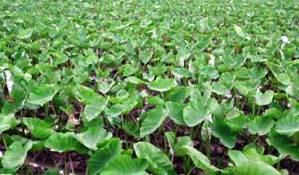
Taro (Colocasia esculenta) growing in Thailand. |
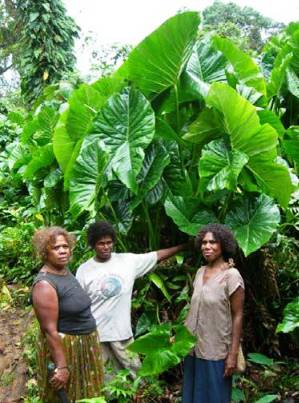
Swamp taro (Cyrtosperma merkusii) in Kiribati. |
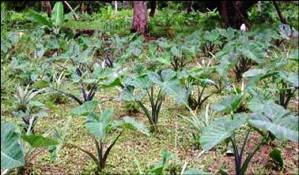
Xanthosoma sp. in Tonga. |
Choice of environment and planting season
Climatic conditions
All three crops require moist soils and none of them tolerate drought.
Taro needs reliable rainfall throughout the growing season or irrigation, moist soils and maximum temperatures of around 25°C.
Xanthosoma grows in lowland and upland situations, with well-distributed rainfall, 1500–2000 mm annually, a mean temperature above 20°C, and freely draining soils of pH 5.5–6.5.
It tolerates light shade but grows well in the open.
Cyrtosperma is generally a hardy species. It tolerates shade and wind but whether it is salt tolerant, as often stated, is less certain.
Planting season
Taro
- If planting setts (lower part of the petiole with the top part of the corm), suckers or cormels in tropical latitudes and dryland conditions, plant at the onset of the rainy season.
- If planting suckers in wetland tropical conditions, plant at any time of the year, as long as water is available.
- If planting cormels in temperate latitudes, plant in spring or, if at high altitude, during the warmer, wetter time of the year.
Xanthosoma
- If water is available, either through irrigation or well-distributed rainfall, plant at any time of the year. There is no seasonality.
- Where rainfall is seasonal, plant when rains become reliable.
Cyrtosperma
- Although seasonal, the best time to plant is during very low tide, or when pits are not flooded, otherwise the young plants may be submerged and/or moved out of position.
Preparation for regeneration
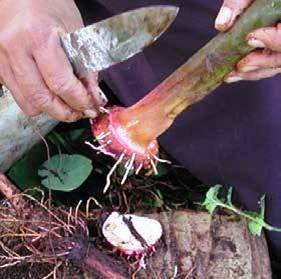 Preparing planting material of taro (Colocasia esculenta) by removing any remaining roots, Tonga. (photo: Grahame Jackson) |
When to regenerate
Taro
- Regenerate plants after a crop cycle of 5–15 months, depending on the variety and growing conditions. The time to regenerate depends on when the mother or central plant starts to die and whether or not the collection is to be ratooned, i.e. suckers are allowed to develop to produce the next crop.
- Ratooning is recommended for dasheen only if the collection is free from major root and leaf diseases. This extends the time between regenerations.
- Ratooning eddoes is possible, but not recommended. Dig up cormels when they are mature and store them in a cool, dry place where they can be checked regularly and replanted when they start to sprout.
Xanthosoma
- Although it is a perennial, it is best to regenerate this crop after 9–12 months when the central or mother plant begins to die down.
- Provided that evaluation for yield or organoleptic qualities is not of concern, the crop can be left in the ground.
- If harvest is delayed for too long, the likelihood of root rots, particularly those caused by Pythium, increases. If there is no threat of root rot the crop can be allowed to ratoon, which doubles the time for regeneration. (See also under Harvesting.)
Cyrtosperma
- Unlike other edible aroids, the time for replanting is flexible.
- Although most varieties mature in 3 years, growing to a height of 3–4 m and with corms of 5–10 kg, the harvest can be delayed.
- Plants can remain in the ground for 10–15 years or longer, even up to 30 years, without deteriorating.
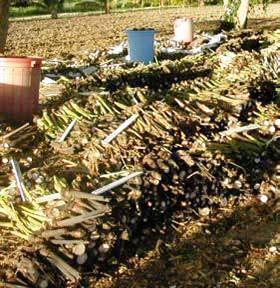 Taro headsets ready for planting on Efate, Vanuatu. (photo: Vincent Lebot/CIRAD) |
Preparation of planting material
Choose healthy planting material. Inspect corms, cormels and headsetts for rots (cause by fungi and/or nematodes) and if found remove with a clean knife or discard the material.
Remove any remaining roots (see photo of preparing planting material). Leave the prepared planting material in a well-ventilated shady place (26–30°C and 90–95% RH) for 3–5 days before planting to allow wounds on the cut surface to heal. Dust corm setts in a fungicide or ash, especially if root rot is known to be a problem in the locality.
Taro
Setts and suckers
- Remove the outer petiole sheaths, especially those that have insect feeding and oviposition punctures (e.g. taro planthoppers, Tarophagus spp.).
- Cut the petioles 30–50 cm above the base and remove the corm, leaving 1–2 cm of corm below the petioles (see photo on the right).
- Small suckers can be planted with the corm intact but check for rots first. If found, discard the plant or remove the rot with a clean knife.
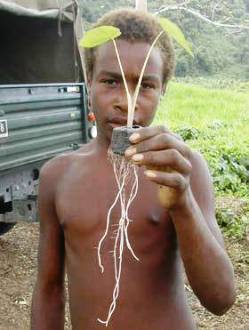 Young taro seedling ready to be transplanted into the field, Efate, Vanuatu. (photo: Vincent Lebot/CIRAD) |
Cormels
- Check and select cormels that have broken dormancy, i.e. the terminal sprout is visible.
- If rots were present in the collection during the previous crop, dust cormels with a fungicide (e.g. thiabendazole, thiram or a copper compound). Remove old roots.
-
Preferably, plant the cormels in a nursery to ensure sprouting and subsequent healthy growth:
- Choose a well-drained site and cultivate the soil to a fine tilth.
- Plant cormels close together (15–20 cm between plants and 15–20 cm between rows).
- Keep the soil moist, no need for fertiliser or shade.
- Label each accession and make a plan of the nursery.
- When plants show uniform growth and one or two new leaves, transfer them to the field (see photo seedling).
Xanthosoma
- Use sections of the central corm (100–150 g) with three or four buds (corm setts) or use cormels.
Cyrtosperma
- Use suckers rather than setts for replanting
- When suckers are limited, use setts; however, setts may not grow as well and take longer to reach maturity than suckers in some countries.
- Cut leaves from the setts or suckers at a downward angle, leaving about 40–50 cm of petiole, with up to 5 cm of the corm, and then place the setts/suckers in a dry shady place for 3–5 days for the wounds to cure before planting.
-
Because there are differences in the choice of planting materials in different countries, consider the following:
- Consult growers as to the most appropriate type of planting material.
- Corms/cormels can also be used as planting material after removal from the mother plant. Plant them in a nursery initially until their root system develops, i.e. 3–4 leaves have emerged, then plant them in the pit or swamp.
- Stop the application of mulch to mother plants 3–4 months before harvest; this will encourage the growth of suckers for regeneration.
Field selection and preparation
Taro
- Plant dryland or upland taro on flat land where there is no waterlogging or, preferably, on hill slopes; plant wetland taro in irrigated fields or swamps.
- Taro can be grown on a variety of soils, but for optimal growth of dryland taro, well-drained clay loams are preferred, with a pH about 5.5–6.5; taro root rot is a risk in waterlogged soils.
- If planting on a slope, avoid planting new collections below those where root rot diseases occurred in the previous crop, as the fungal pathogens spread through ground-water or runoff.
- For dryland and wetland collections, avoid planting taro on land where the crop was planted the previous season; practising crop rotation avoids the build up of pests and diseases.
- For wetland taro, choose sites where water is continuously flowing so that it is cool and rich in dissolved oxygen. Warm, stagnant water results in low oxygen content and can exacerbate corm and root rots. Planting in swamps can be a problem, with build-up of Pythium fungi over time. If unavoidable, it is best to alternate between different swamps or, if others are not available, occasionally grow the collection on dry land and fallow the swamp.
-
Land preparation: Dryland
- Prepare the land by ploughing, disc cultivating and harrowing the soil, cultivating to bury weeds and to obtain a friable soil texture. Deep ripping is recommended if the soil is compacted.
- In the tropics, plant into holes in flat uncultivated (non-tilled) land, so that about one third of the sett is buried. Planting holes should be larger than the size of the corm. Cormels can be planted on flat land, too.
- Alternatively, prepare ridges or furrows for setts or cormels.
- Shallow planting results in corms developing above the soil surface where they may be damaged by insects and rodents. Hence, hilling up will be needed later.
- Shallow planting promotes early sucker development.
- Mounding is also recommended where waterlogging occurs.
-
Land preparation:Wetland
- Plough, disc cultivate and harrow the soil to incorporate crop residues; if possible, keep the land dry for 2–3 months to reduce soil-borne pathogens.
- Puddle the field and then flood it just before or just after planting. The water level should be low at first.
-
In swamps, turn the soil over to bury the weeds before planting. Dig drains around the plots, especially if using the raised bed technique.
Xanthosoma
- Before planting, plough and harrow the soil, or work by mattock or similar tool, then ridge or furrow, depending on prevailing local practice, to facilitate root growth of the corm setts, headsetts or cormels.
- Planting on mounds is an alternative method of cultivation.
- Where land is scarce, and as Xanthosoma is tolerant of shade, plant between mature tree crops, for instance, coconuts or fruit trees. This is not recommended where the collection needs to be characterized and evaluated.
Cyrtosperma
-
Grow Cyrtosperma in pits dug to the fresh water lens or in swamps. If pits are not already there, prepare as follows:
- Dig pits to the water-table, 0.5–3 m deep and as wide as necessary to conserve the collection.
- Add organic matter to form a humus-rich soil or bring in the initial layer from another pit.
- If planting into a swamp, choose sites where there is a more or less continuous supply of slow running water, 20–70 cm deep; avoid swift running water beside streams.
- Choose a site rich in humus or mulch continually.
- Avoid places with a known salinity problem.
- Remove or bury the weeds as they grow in the giant swamp taro patches.
- It is good practice to duplicate the col ection, especial y if it is grown in environments where droughts often occur, as the accessions take many years to reach maturity.
Method of regeneration
Aroids are regenerated using vegetative propagation. Even within clonally propagated species, there may be some level of heterozygosity and it is recommended to plant 5 to 10 plants per accession to maintain the genetic diversity.
Taro varieties differ greatly in their time to maturity. For ease of maintenance and replanting, divide the collection into short-, medium- and long-duration accessions and plant accordingly for ease of management.
Planting layout, density and distance
A number of factors will affect spacing, making it difficult to recommend an optimum spacing or plant density. Plant collections according to the local practice.
Taro
- Wetland taro is usually planted closer together than dryland plantings, suckers closer than mother setts, and cormels closer than setts.
- Where local practice is uncertain, use a spacing of 50 cm between plants and 1 m between rows (20 000 plants per ha) for dryland taro; and 45 cm x 45 cm (50 000 plants per ha) for wetland taro.
- Use a wider spacing if mechanical weeding is carried out or if hil ing up is done by plough.
Xanthosoma
- Where local practice is uncertain, and Xanthosoma is planted on ridges, aim for a spacing of 60 cm between plants in the row and 1 m between rows (16 600 plants per ha) but closer spacings of 60 cm x 80 cm are also used (21 000 plants per ha).
- For mounds, or planting in flat land, use a wider spacing of 90 cm x 90 cm (12 350 plants per ha), 100 cm x 100 cm (10 000 plants per ha) or 100 cm x 150 cm (6600 plants per ha).
Cyrtosperma
- Where local practice is uncertain, aim for a spacing of 50–100 cm between plants in the row and 1 m between rows (10 000–20 000 plants per ha).
- For small accessions, reduce spacing to 50 x 50 cm (40 000 plants per ha).
Planting method
Label each accession with the name, accession number and date planted. Draw a map of the collection immediately after planting. Plant at least 5, preferably 10, plants of each accession in a row. It is best to use long lasting labels (e.g. metal labels and indelible ink).
Taro
- Plant the setts, suckers and cormels vertically, 10–15 cm deep, in ridges, furrows or into flat land as indicated above (see photo below).
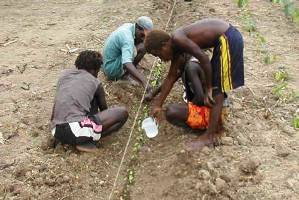
Transplanting taro seedlings into the field, Efate, Vanuatu.
(photo: Vincent Lebot/CIRAD)
Xanthosoma
- Plant corm setts, headsetts or cormels about 10–15 cm deep into furrows or mounds. Direct planting into untilled soil is also possible; in this case, loosen soil to a depth of 15–30 cm.
 Mulching of Cyrtosperma with organic material using local practices, Tarawa, Kiribati. (photo: Grahame Jackson) |
Cyrtosperma
Pits
- In pits, fill individual holes of 20–30 cm diameter for each plant with organic material high in nitrogen (e.g. chopped leaves of Pisonia grandis) as manure and cover with sand and mulch (see Fertilization).
- Plant setts or suckers in the sand with their upper roots at water level and firm the plants in place.
- In some countries, each plant is surrounded with a bottomless basket woven in situ from Pandanus or coconut leaves, and filled continually with a mixture of chopped leaves and soil to produce the largest corms (see photo on the right). As it rots and settles, more is added; alternatively a wall of mud is made around each plant into which mulch is added. These practices begin when plants have six or seven leaves.
Swamps
- Alternatively, plant the setts or suckers in a swamp; if the mud is very deep, plant them on ridges to avoid submerging the young plants; add mulch (leaves or coconut husk) as the plants grow.
- Make holes up to 30 cm deep and 20–30 cm wide, depending on the size of the sett or sucker.
- Tie a stick to each plant (sett/sucker) so that, if the water rises, plants are not washed away.
- Ensure that plants are not overshaded after they are 1–2 m high and provide a constant supply of mulch (see Fertilization).
Crop management
Irrigation
Taro and Xanthosoma
Soil needs to be moist at planting. If irrigation is not available, it is important to plant the collection at the beginning of the wet season. If harvesting and replanting can be matched with seasonal rains, irrigation can be minimized.
Cyrtosperma
Irrigation is not necessary as collections are planted in pits near the water-table or in swamps. Choose sites where local knowledge suggests that droughts will have minimal impact and, if possible, duplicate collections in the field.
Fertilization
Perform soil analysis to determine the amount and type of fertilizer needed. Specific fertilizer types and recommended quantities vary widely from place to place and local practice should be followed. In all cases, check the local practice for the crop first.
Taro
- Apply N, P and K in rings, 10 cm from the edge of the planting point after planting. Apply to cormels when shoots have emerged. Apply lime to acid soils.
- Avoid late applications of fertilizer, especially nitrogen, as the eating quality and palatability of the corms can be affected.
- In general, apply fertilizers, compost or manure as a split dose. Apply the first dose at planting, possibly incorporated into the soil during land preparation, and the second dose 3–4 months later, when the corm enlargement is well under way. Split applications minimise the effects of leaching.
- In wetland situations, the nitrogen fixing aquatic fern, Azolla, can be grown.
- Mulch the taro with banana leaves or coconut fronds as per traditional practices.
Xanthosoma
- If grown on land with good soil fertility there is no need for fertilizer but it may be necessary on intensively cropped land.
- Apply split applications of fertilizer at planting and 2, 4 and 6 months after planting, when harvests are at 9–12 months.
- If the crop is to be ratooned, apply fertilizer again at 12 months and continue applications at 2-month intervals.
Cyrtosperma
- Mulching and fertilization are particularly important for Cyrtosperma planted in pits.
- Use leaves for fertilization and mulching. Check local practices for materials to use, how to apply mulch and quantity required. Take care because adding too much leafy material as mulch during planting can be detrimental to the young setts and suckers.
- Apply mulch when the plants have three or four leaves if mulch was not provided at planting; otherwise apply at one month.
- Apply mulch monthly, usually when new leaves emerge, but cease at least 3 months before harvest if taste is being evaluated, as palatability will be compromised.
Weed management
Taro
- Control weeds in wetland, swamp and raised bed situations with mulch (e.g. banana and coconut leaves).
- Control weeds in dryland plantings by hand weeding, herbicides or mechanical cultivation.
- In wetland production it is important to use mulches and/or to keep the paddies covered with a uniform layer of water to at least 2–3 cm, rather than using herbicides.
- Both pre-emergent and post-emergent herbicides are used for weed control in dryland taro; however, if evaluations of the leaves are required for, say, eating quality, then systemic products should not be used.
- Direct herbicide sprays between the rows and use a guard to shield the petioles from damage. Follow local recommendations for herbicide use.
Xanthosoma
- Ensure adequate control of weeds during the initial 6 months, or until leaves form a canopy and weed growth is suppressed; it is especially important during the time of cormel initiation and development, beginning at 2 months.
- Techniques to maintain appropriate weed control: ploughing and harrowing before planting, application of pre- and post-emergent herbicides, hand weeding, putting soil around the base of plants as they grow and mulching.
Cyrtosperma
- Weed regularly until plants form a natural dense canopy, and remove falling trees and branches that might hinder the growth of young plants.
Common pests and diseases
Contact plant health experts to identify pest and disease symptoms and appropriate control measures. Some of the major pests and diseases of aroids are listed below:
Taro
- Diseases: taro leaf blight, Phytophthora colocasiae; alomae and bobone viruses; root and corm rots, Pythium spp.
- Insect pests: delphacid planthopper, Tarophagus spp.; Papuana beetles; Taro hawkmoth caterpillars, Hippotion celerio; cluster caterpillars, podoptera litura.
Xanthosoma
- Diseases: root and corm rot; dasheen mosaic potyvirus (DsMV); southern blight, Athelia rolfsii; Xanthomonas axonopodis pv. dieffenbachiae causes a leaf spot and blight.
Cyrtosperma
- Dasheen mosaic potyvirus (DsMV) is occasionally seen on plants; Papuana beetle is a problem in pits; Radopholus similis, nematode (very restricted distribution on this host); Lasiodiplodia theobromae cause post-harvest rots.
Harvesting
Normally harvesting is not required if the collection is ratooned, as it regrows in the same field (see When to regenerate, above). Take care during harvesting and subsequent handling not to bruise the cormels. Not all the accessions mature at the same time, even when they are categorised according to time to maturity.
Taro
- Maturity for harvest is indicated by a reduction in the height and number of leaves on the mother plant. Whereas suckers of dasheen continue to grow and develop a ratoon crop, leaves of eddoes yellow and die. Although the time to harvest can be extended past the time of maturity, harvesting should not be delayed if the collection is to be evaluated for quality characteristics.
- Harvest collections on dry days to reduce the risk of suckers and cormels becoming infected by pathogens through wounds made when separating them from the parent plant.
- Carry out harvests systematically: choose plants for regeneration; pull them out; cut suckers to size or choose cormels, and label them immediately. Tie suckers in bundles and place cormels in paper bags, or use baskets for both.
- There is no need to harvest all plants of any one accession at the same time unless yield data is being recorded; leave some plants so that if any of the replanted collection dies they can be replaced easily.
Xanthosoma
- Harvest at any time of the year; usually 10–12 months after planting when the leaves have turned yellow and are beginning to dry.
- If the crop is planted into fertile soil, maturity is often extended up to 18 months as vigorous early leaf growth occurs at the expense of cormel development.
- If yield and palatability are not being recorded, the time to harvest can be extended.
- Xanthosoma can be grown as a biennial or perennial crop.
- If needed, annual harvests can be taken without uprooting the entire plant. This ‘cut-and-come-again’ technique can be repeated for up to 6 years.
Cyrtosperma
Harvest when:
- Numerous suckers have formed around the main plant.
- All leaves turn yellowish.
- There is reduced growth after several years.
- Generally, it takes 2–4 years for the crop to fully mature when grown in pits on atolls, and longer (5–8 years) when in swamps on high islands. However, plants can be left beyond this period; the time to maturity depends on variety and soil type.
Post-harvest management
Taro
- Store suckers for 3–5 days in a shady place (see Preparation of planting material, above).
- Store cormels in a well-ventilated place, ensuring that they are protected from damage by pests.
- Treat cormels with care, as they are prone to rots caused by Lasiodiplodia theobromae and Fusarium spp. if damaged.
- Store cormels at 12°C or thereabouts. If properly cured and healthy, they can be stored for several months.
Xanthosoma
- Store cormels for up to 6 months in a well-ventilated cool place; however loss of quality occurs much earlier. Usually, the cormels are stored for 4–8 weeks before they begin to sprout and need replanting. They can also be stored for a few weeks in a pit in the ground, but this is not recommended for collections that require monitoring in case of loss due to rots or other factors.
- Storage time can be extended if cormels are stored at 15°C and 85% RH.
Note that Xanthosoma can be stored in the ground for months or even years after reaching maturity. (See Harvesting.)
Cyrtosperma
- Setts and suckers can be stored for a few days after harvest, kept in a shady place under leaves or sacking to retain high relative humidity, before replanting.
- Corms store for 3–4 weeks.
Monitoring accession identity
- • When plants reach maturity, check that varieties are as originally described using original Bioversity International descriptor lists (IBPGR 1989; IPGRI 1999) and, if available, photographs of the accessions.
- Check for often occurring somatic mutations. These can be added to the collection if they are clearly labelled with a separate accession number and passport data are recorded. Otherwise, discard them.
Documentation of information during regeneration
The following information should be collected during regeneration:
- Regeneration (nursery) site name and map/GPS reference, if used for cormels
- Name of collaborator
- Accession number(s)
- Type of propagating material (e.g. mother, sucker or cormel)
- Nursery planting date
- Survival rate of propagating material (cormels)
- Nursery (if used) management details (media, watering, fertiliser, weeding, others)
- Field site name and map/GPS reference
- Method(s) of planting
- Field conditions (altitude, precipitation, temperature, soil type, slope, others)
- Number of plants established and planting distance
- Field management details: fertiliser, weeding, pest control practices and dates of any treatments, others
- Harvest date(s)
- Any evaluation undertaken at harvest.
References and further reading
Bioversity International. 2009. Key access and utilization descriptors for taro genetic resources. Bioversity International, Rome, Italy. Available here.
Brown D. 2000. Aroids. Plants of the Arum family (2nd ed.). Timber Press, Portland, Oregon, USA. 392 pp.
Clement CR. 1994. Crops of the Amazon and Orinoco regions: Their origin, decline and future. In: Hernaldo JE, León J, editors. Neglected crops: 1492 from a different perspective. Plant Production and Protection Series No. 26. FAO, Rome, Italy. pp. 195–203.
Coursey DC. 1968. The edible aroids. World Crops 20:25–30.
Denham T. 2004. Early agriculture in the highlands of New Guinea: an assessment of Phase 1 at Kuk Swamp. In: Attenbrow V, Fullagar R, editors. A Pacific Odyssey: Archaeology and Anthropology in the Western Pacific. Records of the Australian Museum, Supplement 29. Australian Museum, Sydney, Australia. pp. 47–57.
Edison S, Unnikrishnan M, Vimala B, Pillai SV, Shhela MN, Sreekumari MT, Abraham K. 2006. Biodiversity of tropical tuber crops in India. NBA Scientific Bulletin No. 7. National Biodiversity Authority, Chennai, India. 60 pp.
Giacometti DC, León J. 1994. Tannia. Yautia (Xanthosoma sagittifolium). In: Hernaldo JE, León J, editors. Neglected crops: 1492 from a different perspective. Plant Production and Protection Series No. 26. FAO, Rome, Italy. pp. 253–258.
Hay A. 1988. Cyrtosperma (Araceae) and its Old World allies. Blumea 33:427–469.
Hay A. 1990. Aroids of Papua New Guinea. Christensen Research Institute, PNG.
Hay A. 1998. Botanical varieties in taro, Colocasia esculenta: leaving old baggage behind. A report on taro consultancy No. CO2C. IPGRI, Rome, Italy. 13 pp.
Hernández Bermejo JE, León J, editors. 1994. Neglected crops: 1492 from a different perspective. Plant Production and Protection Series No. 26. FAO, Rome, Italy.
Hetterscheid W. 2004. Genera List (Cyrtosperma). International Aroid Society. Available from: http://www.aroid.org/genera/cyrtosperma/Cyrtospermalist.html. Date accessed: 1 August 2008.
IBPGR. 1989. Descriptors for Xanthosoma. IBPGR, Rome, Italy.
Iese V. 2005. Characterization of the giant swamp taro (Cyrtosperma chamissonis (Merr.) Schott) using morphological features, genetic fingerprinting and traditional knowledge of farmers in the Pacific. MSc Thesis. Biology Department, School of Pure and Applied Sciences, The University of the South Pacific, Suva, Fiji.
IPGRI. 1999. Descriptors for Taro (Colocasia esculenta). IPGRI, Rome, Italy.
Kreike CM, van Eck HJ, Lebot V. 2004. Genetic diversity of taro, Colocasia esculenta (L.) Schott, in Southeast Asia and the Pacific. Theoretical and Applied Genetics 109:761–768.
Lebot V. 1999. Biomolecular evidence for plant domestication in Sahul. Genetic Resources and Crop Evolution 46:619–628.
Matthews PJ. 1991. A possible tropical wildtype taro: Colocasia esculenta var. aquatilis. Indo-Pacific Prehistory Association Bulletin 11:69–81.
Matthews PJ. 2002. Potential of root crops for food and industrial resources. In: Potential of root crops for food and industrial resources. Twelfth Symposium of The International Society for Tropical Root Crops (ISTRC), 10–16 September 2000, Tsukuba, Japan. pp. 524–533.
Matthews PJ. 2002. Taro storage systems. In: Shuji Y, Matthews P, editors. Vegeculture in Eastern Asia and Oceania. JCAS Symposium Series 16. The Japan Center for Area Studies (JCAS), National Museum of Ethnology, Osaka, Japan. pp. 135–163.
Matthews PJ. 2004. Genetic diversity of taro, and the preservation of culinary knowledge. Ethnobotany Research & Applications 2:55–71.
Onokpise OU, Wutoh JG, Ndzana X, Tambong JT, Mekoba MM, Sama AE, Nyochembeng L, Aguegia A, Nzietchueng S, Wilson JG, Burns M. 1999. Evaluation of Macabo cocoyam germplasm in Cameroon. In: Janick J, editor. Perspectives on New Crops and New Uses.
ASHS Press, Alexandria, VA, USA. pp. 394–396.
Onwueme IC. 1978. Colocasia and Xanthosoma (Cocoyams). In: Onwueme IC. The Tropical Tuber Crops: yams, cassava, sweet potato, and cocoyam. J Wiley and Sons Ltd., New York, USA. pp. 589–606.
Onwueme IC, Charles WB. 1994. Cultivation of cocoyam. In: Tropical root and tuber crops. Production, perspectives and future prospects. FAO Plant Production and Protection Paper 126, FAO, Rome, Italy. pp. 139–161.
Plucknett DL. 1976. Edible aroids. In: Simmonds, NW, editor. Evolution of Crop Plants.
Longman Inc, New York, USA. pp. 10–12.
Shaw T. 1976. Early crop in Africa: A review of the evidence. In: Harlan JR, de Wit JMJ, Stemler ABL. Origins of African Plant Domestication. Mouton, The Hague, Netherlands. pp. 108–153.
Thompson S. 1982. Cyrtosperma chamissonis (Aracae): Ecology, distribution, and economic importance in the South Pacific. Journal d’ Agriculture Traditionalelle et de Botanique Applliquee 29(2):185–213.
Wilson JE. 1984. Cocoyam. In: Goldsworthy PR, Fisher NM, editors. The Physiology of Tropical Field Crops. John Wiley and Sons Ltd., New York, USA. pp. 589–605.
Acknowledgements
These guidelines have been peer reviewed by V. Ramanatha Rao, India, and Mary Taylor, Secretariat of the Pacific Community (SPC), Fiji.
Comments
- No comments found





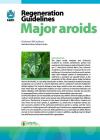
Leave your comments
Post comment as a guest